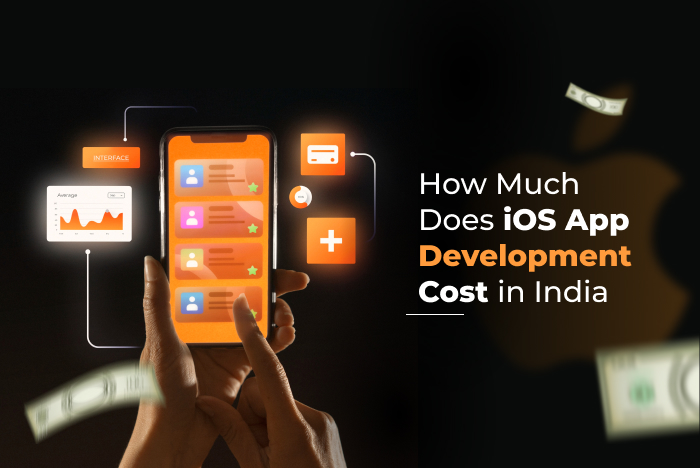Developing iOS apps has become a major factor in determining our digital experiences in the rapidly evolving world of technology. However, what is iOS app development exactly? Why should someone create an app? Who are iOS developers? This indepth manual seeks to clarify the complexities of iOS app development by examining its benefits and drawbacks, contrasting it with Android, and investigating its significance in 2024.
We'll explore the history of iOS, the different kinds of app development, the effects of app development worldwide, and wrap up by dispelling the myths surrounding the expenses of developing iOS apps and the developers who create these technological marvels.
Table of Content
Pros and Cons of iOS App Development
Difference Between Android and iOS
Importance of iOS App Development in 2024
What was the growth of ios in past to present?
What is the Types of App Development?
Impact of App Development on the World
The Cost of iphone iOS App Development in india
Factors Affecting the Cost of iOS App Development
Factors that Decide the Cost of iOS
Hidden Cost of iPhone App Development You Should Know
What is iOS App Development?
iOS app development refers to the creation of applications specifically designed to run on Apple's iOS operating system, powering devices like iPhones, iPads, and iPod Touch. These applications leverage the unique features and functionalities offered by iOS to deliver seamless and userfriendly experiences.
iOS app development is the creative and technical process of building applications specifically designed to run on Apple's iOS operating system, which powers devices like iPhones, iPads, and iPod Touch. Think of iOS as the brain behind these Apple gadgets, and iOS app development as the art and science of crafting digital tools and experiences that seamlessly integrate with this operating system.
In simpler terms, when you open an app on your iPhone – be it for messaging, shopping, gaming, or anything else – it's the result of iOS app development. Developers, the creative minds behind these digital wonders, are like architects and builders constructing the intricate structures that we interact with on our Apple devices.
What is an iOS Developer?
In iOS developer is a skilled professional responsible for creating, designing, and maintaining applications that run on Apple's iOS operating system. In simpler terms, they are the architects and builders behind the apps you use on your iPhones, iPads, and iPod Touch. These developers use programming languages like Swift or ObjectiveC to write the code that brings apps to life, enabling them to perform various tasks and provide engaging user experiences.
The role of an iOS app developer involves more than just coding. We work collaboratively with designers, testers, and other team members to ensure that the app not only functions flawlessly but also looks visually appealing. Imagine them as the storytellers, crafting narratives in the form of app functionalities and features to create a seamless and enjoyable user journey.
Why Create an App for Your Business?
Designing an app is like creating a helpful and enjoyable digital tool for your phone or tablet. It's about making something that solves a problem, like ordering food easily or playing games for fun. The design part is important because it makes the app easy to use and nice to look at, making your experience smooth and enjoyable.
Apps are designed to make your life simpler, whether it's for chatting with friends, organizing your tasks, or just having some fun. Good design also helps businesses represent themselves well and stand out in the digital world. So, designing an app is like crafting a digital friend that makes your life better and more enjoyable.
Pros and Cons of iOS App Development
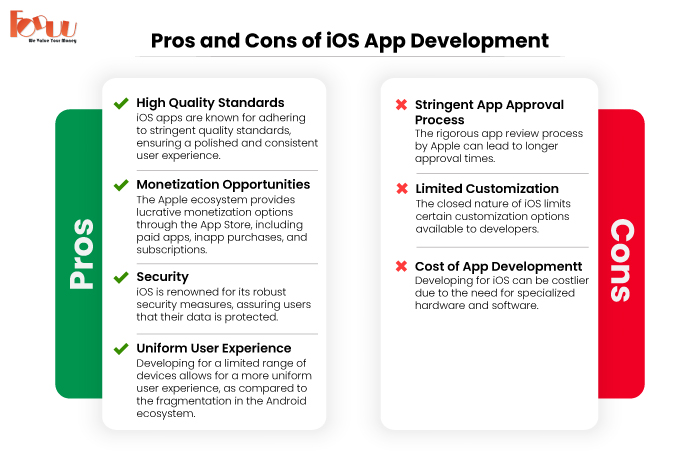
Pros:
1. High Quality Standards: iOS apps are known for adhering to stringent quality standards, ensuring a polished and consistent user experience.
2. Monetization Opportunities: The Apple ecosystem provides lucrative monetization options through the App Store, including paid apps, inapp purchases, and subscriptions.
3. Security: iOS is renowned for its robust security measures, assuring users that their data is protected.
4. Uniform User Experience: Developing for a limited range of devices allows for a more uniform user experience, as compared to the fragmentation in the Android ecosystem.
Cons:
1. Stringent App Approval Process: The rigorous app review process by Apple can lead to longer approval times.
2. Limited Customization: The closed nature of iOS limits certain customization options available to developers.
3. Cost of App Development: Developing for iOS can be costlier due to the need for specialized hardware and software.
Difference Between Android and iOS Development
Certainly! Here are key points highlighting the differences between Android and iOS development:
1. Operating System:
Android: Developed by Google, Android is an opensource operating system used by a variety of manufacturers on diverse devices.
iOS: Developed by Apple, iOS is a closedsource operating system exclusive to Apple devices like iPhones, iPads, and iPod Touch.
2. Programming Languages:
Android: Primarily uses Java and Kotlin for app development.
iOS: Primarily uses Swift and ObjectiveC for app development.
3. Development Environment:
Android: Developers use Android Studio as the official integrated development environment (IDE).
iOS: Developers use Xcode as the official IDE for iOS app development.
4. App Distribution:
Android: Apps are distributed through the Google Play Store and other thirdparty stores.
iOS: Apps are exclusively distributed through the Apple App Store.
5. Device Fragmentation:
Android: Runs on a wide range of devices from different manufacturers, leading to device fragmentation.
iOS: Limited to Apple devices, resulting in a more consistent user experience across devices.
6. Development Flexibility:
Android: Offers more flexibility and openness, allowing developers to customize and experiment with different features.
iOS: Follows a more closed and controlled environment, restricting certain customizations to maintain a consistent user experience.
7. User Interface Guidelines:
Android: Follows Material Design guidelines, emphasizing a clean and intuitive design.
iOS: Follows Human Interface Guidelines, prioritizing clarity, depth, and simplicity in design.
8. App Monetization:
Android: Offers various app monetization options, including advertising, inapp purchases, and subscription models.
iOS: Similarly provides monetization options like ads, inapp purchases, and subscriptions, with a generally higher user willingness to pay.
9. Development Complexity:
Android: Can be perceived as more complex due to the variety of devices and screen sizes, requiring additional considerations for compatibility.
iOS: Generally considered less complex as developers target a more controlled range of Apple devices.
10. Development Cost:
Android: Development costs may vary based on the need for extensive testing across multiple devices.
iOS: Development costs are often perceived as more predictable due to a more controlled device ecosystem.
11. Release Process:
Android: Apps can be released more quickly as the approval process on the Google Play Store is typically faster.
iOS: The App Store review process is more stringent, leading to a longer approval time for app releases.
12. Market Share:
Android: Enjoys a larger market share globally due to its availability on a multitude of devices.
iOS: Holds a significant market share, particularly in regions with a strong presence of Apple devices.
Importance of iOS App Development in 2024
In 2024, the digital landscape will be shaped by multiple important factors, making the development of iOS apps essential. Apple's user base continues to expand, encompassing a vast audience of iPhone, iPad, and iPod Touch users.
This growth presents significant business opportunities for developers and businesses, as iOS users are renowned for their high engagement levels and propensity to spend on apps and inapp transactions. The Apple App Store remains a lucrative platform, offering various revenue streams, including paid apps, inapp purchases, and subscriptions.
The trust and prestige associated with iOS contribute to brand visibility, making iOS app development an integral aspect of a brand's digital strategy. Technological advancements introduced with each iOS update provide developers with the tools to create innovative and cuttingedge experiences, ensuring their apps stay at the forefront of user expectations. The global market penetration facilitated by iOS is a notable advantage for businesses seeking to reach a diverse and international audience.
What was the growth of iOS in past to present?
When we look back at iOS's development over time, we see a journey of transformation.The introduction of the App Store in 2008 marked a turning point, propelling iOS into a thriving ecosystem for developers. The expansion of the iOS lineup with devices like iPads and Apple Watches broadened the scope of app development. The adoption of Swift as a programming language in 2014 streamlined the development process, attracting a more extensive community of developers.
Apple's commitment to user privacy and security has resonated with consumers, contributing to the platform's growth. Regular updates to the iOS operating system ensure that users have access to the latest features, motivating developers to create apps that leverage these capabilities. The global adoption and market share of iOS, particularly in regions like North America and Europe, underscore its sustained growth as a dominant force in the mobile app landscape.
What is the Types of App Development?
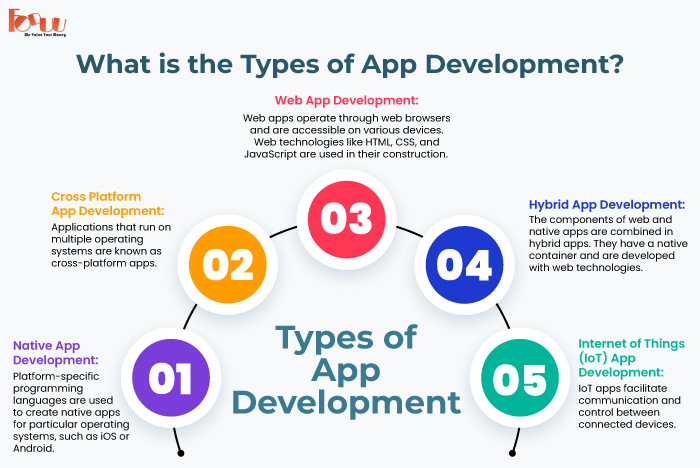
Platform-specific programming languages (Java or Kotlin for Android, Swift or Objective-C for iOS) are used to create native apps for particular operating systems, such as iOS or Android. They offer optimal performance and take full advantage of device features.
1. Native App Development:
Platform-specific programming languages (Java or Kotlin for Android, Swift or Objective-C for iOS) are used to create native apps for particular operating systems, such as iOS or Android.They offer optimal performance and take full advantage of device features.
2. Cross Platform App Development:
Applications that run on multiple operating systems are known as cross-platform apps. They use frameworks like React Native, Flutter, or Xamarin, enabling developers to write code once and deploy it on both iOS and Android platforms.
3. Web App Development:
Web apps operate through web browsers and are accessible on various devices. Web technologies like HTML, CSS, and JavaScript are used in their construction. Web apps are platformindependent but may have limitations compared to native apps in terms of performance and access to device features.
4. Hybrid App Development:
The components of web and native apps are combined in hybrid apps. They have a native container and are developed with web technologies. By doing this, they can still access device features and stay cross-platform compatible. Hybrid app development frequently makes use of frameworks like Cordova and Ionic.
5. Internet of Things (IoT) App Development:
IoT apps facilitate communication and control between connected devices. They enable users to interact with and manage smart devices, wearables, and other IoTenabled products. Development involves integrating software with hardware components.
Impact of App Development on the World:
◦ Apps have bridged geographical gaps, facilitating instantaneous communication through messaging, social media, and video conferencing apps.
◦ The app development industry has become a powerhouse for economic growth, fostering entrepreneurship, creating job opportunities, and contributing significantly to GDP.
◦ Educational apps have revolutionized learning, providing accessible and interactive platforms for skill development and knowledge acquisition.
◦ Health and fitness apps have empowered individuals to take control of their wellbeing, while telemedicine apps have expanded healthcare accessibility.
◦ Mobile banking and financial apps have played a crucial role in promoting financial inclusion, providing convenient and secure solutions for managing finances.
◦ Apps have reshaped the entertainment landscape, influencing how we consume music, movies, and games through streaming services, gaming apps, and interactive platforms.
◦ Smart city apps contribute to efficient urban living, optimizing traffic management, public transportation, and utilities.
◦ Productivity apps and collaboration tools have transformed work processes, facilitating remote work and enhancing overall efficiency in the modern workplace.
The Cost of iphone iOS App Development in India:
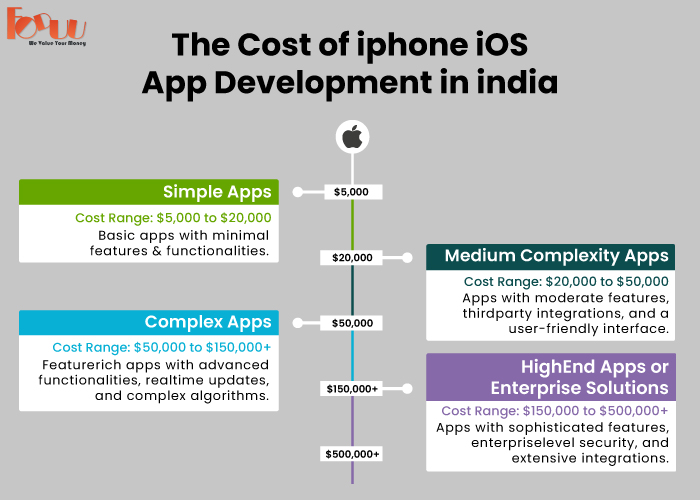
Creating an iphone iOS app involves various factors that influence the overall cost. Here are key considerations:
Certainly, providing an exact cost for iphone and iOS app development can be challenging as it depends on various factors, and each project is unique. However, I can offer a general overview of the cost range based on the complexity of the app:
1. Simple Apps:
Basic apps with minimal features and functionalities.
Cost Range: $5,000 to $20,000.
2. Medium Complexity Apps:
Apps with moderate features, thirdparty integrations, and a userfriendly interface.
Cost Range: $20,000 to $50,000.
3. Complex Apps:
Featurerich apps with advanced functionalities, realtime updates, and complex algorithms.
Cost Range: $50,000 to $150,000+.
4. HighEnd Apps or Enterprise Solutions:
Apps with sophisticated features, enterpriselevel security, and extensive integrations.
Cost Range: $150,000 to $500,000+.
It's essential to note that these are rough estimates, and the actual cost can vary based on specific requirements, design complexity, development time, and the hourly rates of developers.
Let's Explore the Cost of Hiring iOS Developers:
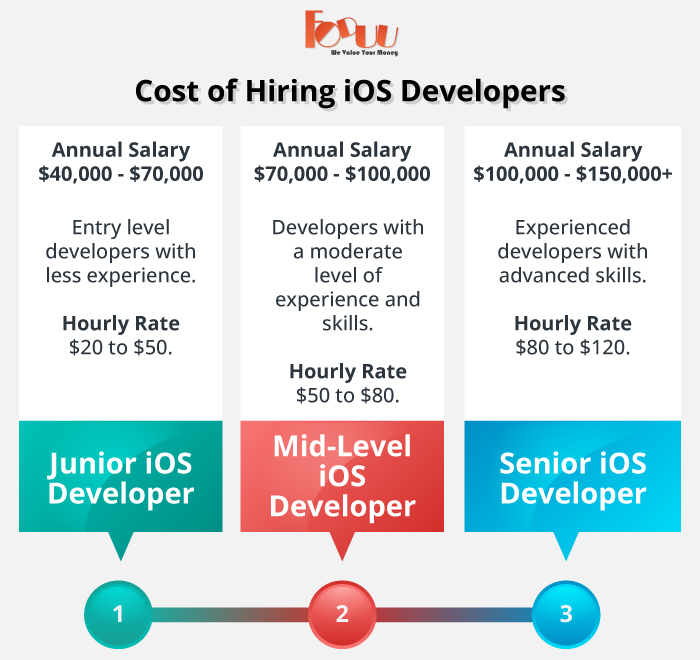
1. Junior iOS Developer:
Cost of Entry level developers with less experience.
Hourly Rate: $20 to $50.
Annual Salary: $40,000 to $70,000.
2. MidLevel iOS Developer:
Developers with a moderate level of experience and skills.
Hourly Rate: $50 to $80.
Annual Salary: $70,000 to $100,000.
3. Senior iOS Developer:
Experienced developers with advanced skills.
Hourly Rate: $80 to $120.
Annual Salary: $100,000 to $150,000+.
These rates are approximate, and actual costs can vary based on factors like the developer's location, expertise in specialized areas (such as AR or ML), and the level of demand for their skills.
Keep in mind that these are only approximate costs; the real cost for your particular project should be ascertained after you have discussed your needs with individual iOS developers or an iPhone app development company in India. When planning a budget for an iphoneiOS app development in india project, it's also critical to take recurring expenses like maintenance, updates, and prospective feature additions into account.
Factors Affecting iOS App Development Cost
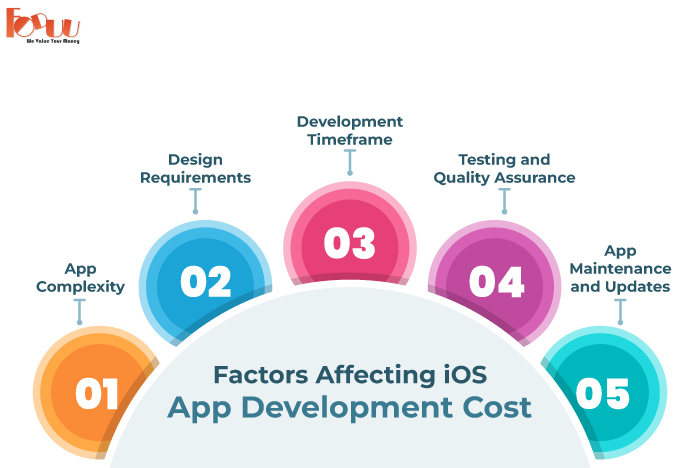
Several factors will affect the cost of your iPhone app development.
1. App Complexity:
The complexity of the app, including features, functionalities, and integrations, significantly impacts the development cost.
2. Design Requirements:
Highquality and intricate designs may incur additional costs. A visually appealing app with a userfriendly interface often demands more investment.
3. Development Timeframe:
The time required for development influences costs. Urgent projects may require more resources and, consequently, result in higher expenses.
4. Testing and Quality Assurance:
Rigorous testing and quality assurance processes ensure a bugfree app, but they contribute to the overall development cost.
5. App Maintenance and Updates:
Factoring in ongoing maintenance and updates is essential for longterm success, as it ensures the app remains functional and secure.
Factors That Decide Cost of iOS Developer?
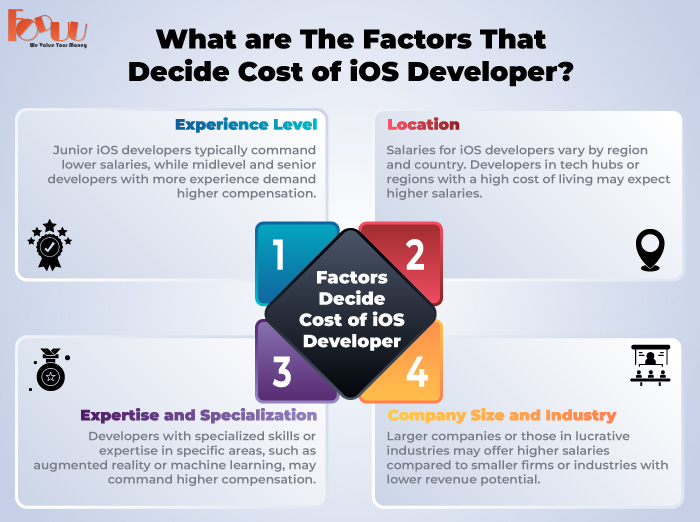
The compensation of iPhone app developers India can vary based on factors such as experience, location, and expertise.
1. Experience Level:
Junior iOS developers typically command lower salaries, while midlevel and senior developers with more experience demand higher compensation.
2. Location:
Salaries for iOS developers vary by region and country. Developers in tech hubs or regions with a high cost of living may expect higher salaries.
3. Expertise and Specialization:
Developers with specialized skills or expertise in specific areas, such as augmented reality or machine learning, may command higher compensation.
4. Company Size and Industry:
Larger companies or those in lucrative industries may offer higher salaries compared to smaller firms or industries with lower revenue potential.
Hidden Cost of iPhone App Development You Should Know
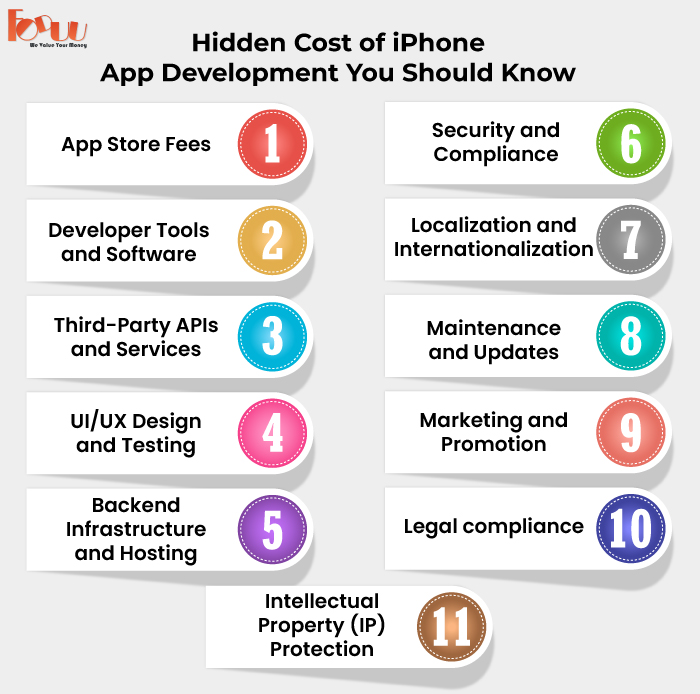
Developing an iPhone app can be an exciting venture, but it's essential to be aware of potential hidden costs that may arise throughout the development process. While the initial budget may cover the core aspects of app development, there are several additional expenses that developers should consider to ensure a successful and sustainable project.
Here are some hidden costs of iPhone app development that you should be aware of:
1. App Store Fees:
Apple charges an annual fee for developers to publish their apps on the App Store. This fee is typically around $99 per year for individuals or $299 per year for organizations. While this cost may seem nominal, it's essential to factor it into your budget, especially for long-term app maintenance and updates.
2. Developer Tools and Software:
Developing an iPhone app requires access to various developer tools and software, some of which may come with subscription fees or one-time purchases. For example, Xcode, Apple's integrated development environment (IDE) for iOS app development, is free to download, but there may be additional costs for certain plugins, libraries, or third-party tools that enhance the development process.
3. Third-Party APIs and Services:
Many iPhone apps rely on third-party APIs (Application Programming Interfaces) and services to integrate additional functionalities such as mapping, analytics, payment processing, or social media integration. While some APIs offer free tiers or usage-based pricing models, others may require monthly subscriptions or usage fees based on the volume of requests or transactions.
4. UI/UX Design and Testing:
Investing in high-quality UI (User Interface) and UX (User Experience) design is crucial for creating an engaging and intuitive app that resonates with users. Hiring experienced designers and conducting user testing sessions may incur additional costs beyond the initial development budget. Iterative design revisions and usability improvements may also prolong the development timeline and incur additional expenses.
5. Backend Infrastructure and Hosting:
If your iPhone app requires server-side functionality or data storage, you'll need to budget for backend infrastructure and hosting costs. This may include expenses related to cloud hosting services, database management systems, server maintenance, and scalability enhancements to accommodate growing user demand and data storage requirements.
6. Security and Compliance:
Ensuring the security and compliance of your iPhone app with industry standards and regulatory requirements may involve additional costs for security audits, penetration testing, compliance certifications, and data protection measures. Investing in robust security practices from the outset can help mitigate the risk of data breaches, privacy violations, and legal liabilities down the line.
7. Localization and Internationalization:
If you plan to release your iPhone app in multiple countries or regions, you'll need to consider localization and internationalization costs. This may involve translating app content, adapting user interfaces to different languages and cultural preferences, and complying with local regulations and App Store guidelines for each target market.
8. Maintenance and Updates:
After launching your iPhone app, ongoing maintenance and updates are essential for addressing bugs, adding new features, improving performance, and ensuring compatibility with the latest iOS versions and devices. Budgeting for post-launch support, bug fixes, feature enhancements, and regular app updates is crucial for sustaining user engagement and retaining app relevance over time.
9. Marketing and Promotion:
Promoting your iPhone app and acquiring users often requires investment in marketing and promotional activities such as app store optimization (ASO), digital advertising, social media marketing, influencer outreach, public relations, and user acquisition campaigns. Allocating a portion of your budget to marketing efforts can help increase app visibility, attract users, and drive downloads.
10. Legal compliance
Protecting your app's intellectual property rights and ensuring legal compliance may involve costs for trademark registration, copyright protection, terms of service agreements, privacy policies, and liability insurance.
11. Intellectual Property (IP) Protection:
Consulting with legal professionals to navigate licensing agreements, intellectual property disputes, and regulatory requirements can help safeguard your app and mitigate legal risks.
Conclusion:
In conclusion, the world of iPhone app development company India is dynamic and impactful. From the roles of iOS developers to the pros and cons of iphone iOS development, this guide provides a comprehensive overview. As we navigate the evolving landscape of technology, the importance of iOS app development in 2024 becomes increasingly evident.
The growth of iOS, diverse types of app development, and the global impact of these digital solutions underscore the significance of this field. While the cost of iOS app development and hiring iphone iOS developers in india may pose challenges, the potential for innovation, user engagement, and business success makes the journey worthwhile.
As we continue to witness the transformative power of mobile apps, the role of iOS development remains at the forefront of shaping our digital future.
FAQ's about iOS App Cost in India

